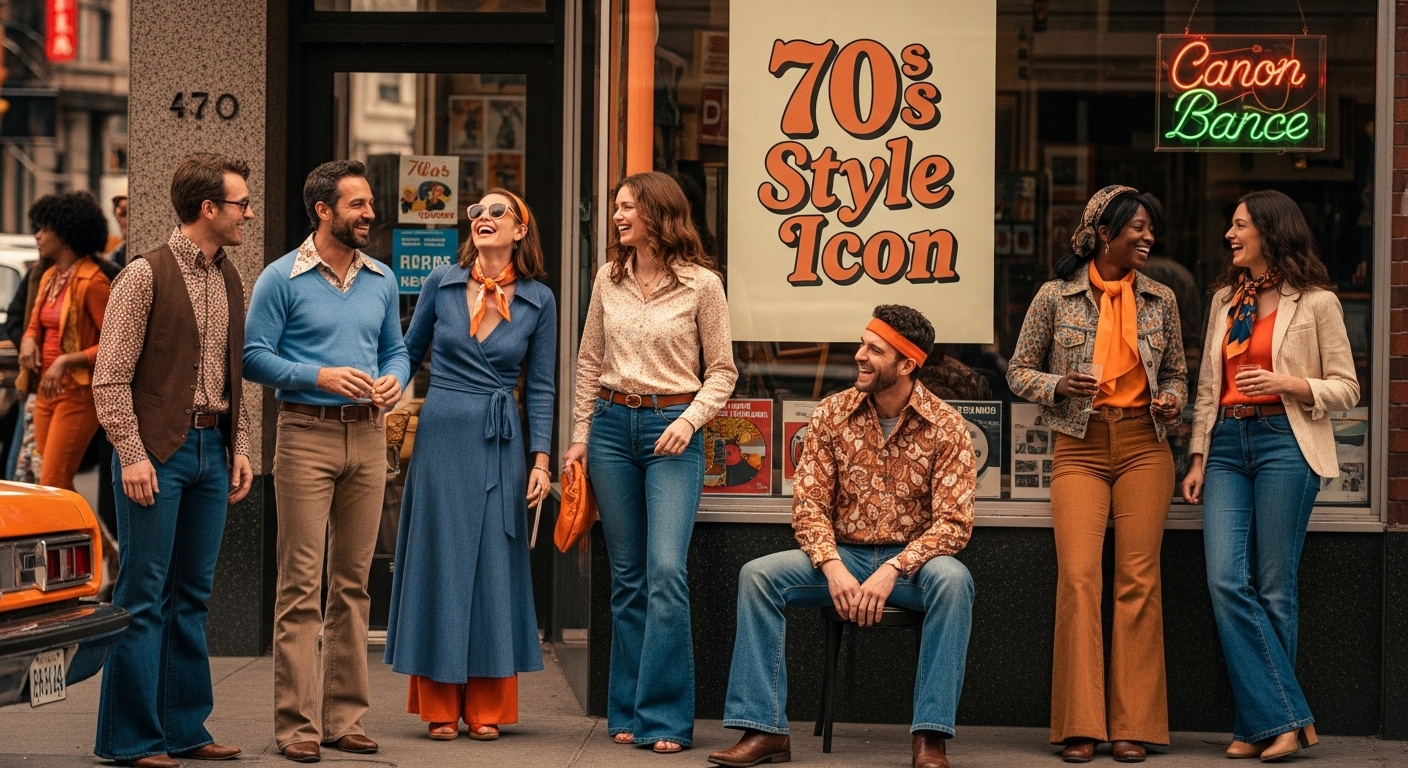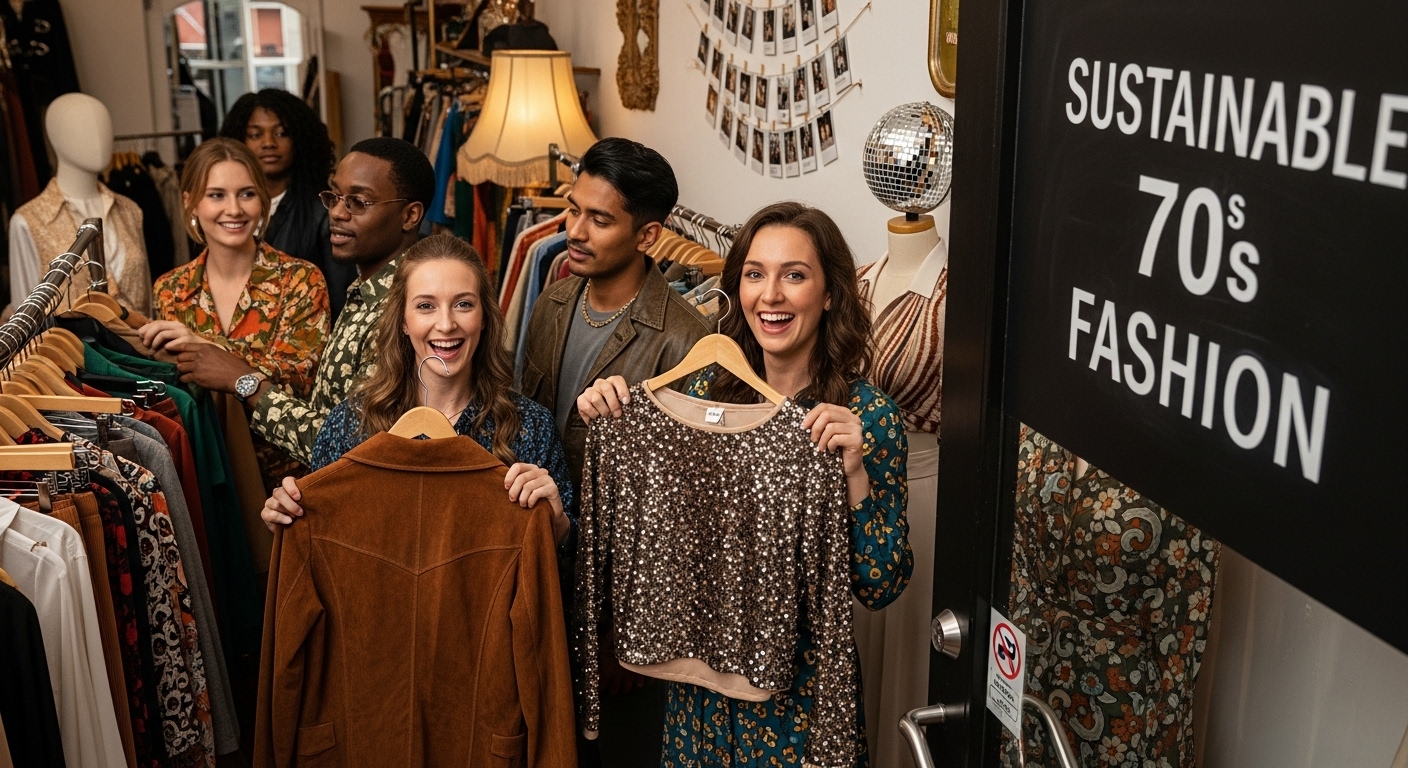What is 70s Style? Understanding a Retro Fashion Icon
- Emma

- Sep 13
- 9 min read

Seventies fashion changed everything. Designers swapped old-school fabrics for bold new textures like lurex, velour, and nylon, a leap that reflected the era’s obsession with progress and expression. Think psychedelic patterns, wild flares, and platform shoes. Most people assume these trends were all about looking outrageous or keeping up with celebrity culture, but the real shock is how these styles smashed social boundaries and carried hidden messages of rebellion. What seems like glitz and retro fun is actually a story of protest, creativity, and freedom stitched into every seam.
Table of Contents
Quick Summary
Takeaway | Explanation |
Emphasise bold, expressive style | The 1970s celebrated individuality and cultural rebellion through daring fashion choices. |
Utilise innovative materials | Synthetic fabrics like lurex and velour defined the era, symbolising technological progress. |
Prioritise personal expression | Fashion in the 70s was a vehicle for social commentary, breaking gender norms and embracing individuality. |
Incorporate vibrant colour palettes | Earthy hues like mustard yellow and avocado green dominated, making accessories statements of identity. |
Adopt sustainable vintage practices | Vintage 70s fashion offers environmentally friendly alternatives, promoting circular fashion principles and conscious consumption. |
Defining 70s Style: Key Characteristics and Trends
The 1970s represented a revolutionary period in fashion, marking a significant departure from previous decades through its bold, expressive aesthetic. Research from the University of Warwick highlights how this era transcended traditional fashion boundaries, introducing unprecedented levels of personal expression and cultural rebellion through clothing.
The Material Revolution
Fabric selection became a defining characteristic of 70s style, moving far beyond conventional textiles. Designers embraced synthetic materials with enthusiasm, introducing innovative textures like lurex, velour, and nylon that captured the decade’s futuristic imagination. These materials symbolised a break from traditional natural fibres, representing technological progress and a forward-looking aesthetic.
Silhouettes and Cultural Statements
The 70s fashion landscape was remarkably diverse, featuring silhouettes that ranged from ultra-fitted to dramatically loose. Check out our comprehensive guide on the timeless influence of 1970s fashion to understand how these styles emerged. Key trends included:
High-waisted, wide-legged trousers
Bell-bottom jeans
Wrap dresses
Platform shoes
Psychedelic print shirts
These designs weren’t merely fashion statements but powerful cultural expressions reflecting the era’s social movements, challenging traditional gender norms and celebrating individual freedom.
Colour Palette and Accessories
Colour played a crucial role in 70s style, with earthy tones like mustard yellow, burnt orange, and avocado green dominating the palette. Accessories became bold statements of personal identity, with oversized sunglasses, chunky jewellery, and statement belts completing the quintessential 70s look. The decade’s fashion was less about conformity and more about celebrating individual creativity and self-expression.
To clarify the era’s distinctive aesthetic, the following table summarises the key features and characteristics that defined 1970s style across materials, silhouettes, colours, and cultural meaning.
Feature / Characteristic | Description |
Signature Materials | Lurex, velour, and nylon symbolised technological progress and a futuristic mindset |
Iconic Silhouettes | High-waisted, wide-legged trousers, bell-bottom jeans, wrap dresses, platform shoes |
Colour Palette | Earthy tones such as mustard yellow, burnt orange, avocado green |
Accessories | Oversized sunglasses, chunky jewellery, statement belts |
Patterns and Prints | Psychedelic and geometric prints reflecting individuality and rebellion |
Cultural Significance | Expression of creativity, breaking gender norms, and involvement in social movements |
Subcultural Influences | Punk rock, disco, hippie, and street fashion movements shaping style and identity |
The Cultural Impact of 70s Style on Fashion and Design
The 1970s represented more than just a fashion era; it was a profound cultural movement that reshaped societal norms, artistic expression, and individual identity. Research from the British Council highlights how fashion became a powerful medium for social commentary and personal rebellion during this transformative decade.
Breaking Social Boundaries
Fashion in the 1970s transcended mere clothing, becoming a powerful tool for social transformation. The decade witnessed an unprecedented challenge to traditional gender constructs, with unisex clothing and androgynous styles emerging as mainstream fashion statements. Designers and wearers alike used clothing as a form of political and personal expression, dismantling rigid societal expectations about appearance and identity.
Subcultures and Style Movements
Explore the fascinating evolution of retro fashion movements to understand the deeper cultural significance. The 1970s saw the rise of multiple influential subcultures that fundamentally reshaped fashion narratives:
Punk rock’s anti-establishment aesthetic
Disco’s glamorous and flamboyant style
Hippie movement’s bohemian and free-spirited designs
Emerging street fashion reflecting urban youth culture
These subcultures weren’t just fashion trends but powerful statements of social resistance, challenging mainstream cultural norms and creating spaces for alternative identities.
Here is a comparison table outlining the major subcultures and style movements of the 1970s, highlighting their distinctive fashion elements and cultural symbolism.
Subculture / Movement | Defining Style Elements | Cultural Symbolism |
Punk Rock | DIY aesthetics, ripped clothing, safety pins | Anti-establishment, rebellion, youth resistance |
Disco | Sequins, flared trousers, platform shoes | Glamour, escapism, nightlife, collective celebration |
Hippie | Flowing fabrics, tie-dye, ethnic motifs | Peace, free-spiritedness, anti-war, counterculture |
Street Fashion | Mix of urban styles, casual sportswear | Representation of urban youth, accessibility, diversity |
Androgynous/Unisex | Gender-fluid ensembles, neutral tailoring | Challenging gender norms, personal expression, political identity |
Global Design Influence
The cultural impact of 70s style extended far beyond clothing, influencing graphic design, interior decoration, architecture, and product design. Bold geometric patterns, vibrant colour palettes, and experimental materials became hallmarks of 70s design philosophy. Furniture, album covers, automobile designs, and architectural elements all reflected the decade’s revolutionary aesthetic, demonstrating how fashion was intrinsically linked to broader cultural movements of creativity and individual expression.
Underlying Influences: Music, Art, and Social Movements
The 1970s fashion landscape was intrinsically woven with the vibrant cultural tapestry of music, art, and social movements, creating a dynamic ecosystem where clothing became a powerful form of self-expression. According to research from the BBC’s British Style Genius, this era represented a profound youth revolution that transcended traditional boundaries of creative expression.
Musical Rebellion and Fashion Statements
Musical genres became pivotal architects of fashion during the 1970s. Punk rock, disco, and glam rock didn’t just produce sounds but generated entire aesthetic universes. Bands like The Sex Pistols, David Bowie, and ABBA didn’t merely influence music but completely reimagined how individuals could dress and present themselves. Their distinctive styles challenged conventional fashion norms, transforming musicians into cultural icons who redefined personal style.
Artistic Movements and Visual Language
Explore the intricate connections between vintage fashion and artistic movements to understand this complex relationship. Visual artists and designers collaborated to create groundbreaking aesthetic expressions that challenged traditional representations:
Pop Art’s bold, graphic sensibilities
Minimalist design principles
Psychedelic visual aesthetics
Conceptual art’s experimental approaches
These artistic movements provided a radical visual vocabulary that fashion designers eagerly embraced, translating complex artistic concepts into wearable forms.
Social Movements and Sartorial Resistance
Clothing in the 1970s was never neutral; it was a deliberate political statement. Civil rights movements, feminist struggles, and anti-war protests found powerful expression through fashion. T-shirts transformed from simple garments into canvases of protest, communicating complex social messages through fabric and design. The era’s fashion represented a profound dialogue between personal identity, social consciousness, and creative expression, making every outfit a potential act of cultural rebellion.
Sustainable Fashion and Vintage Resurgence in 70s Style
The contemporary vintage fashion movement represents far more than nostalgic appreciation; it embodies a critical response to modern fashion’s environmental challenges. Research from the University of Huddersfield reveals how vintage fashion has become a significant sustainable alternative to fast-fashion consumption.
Ecological Consciousness and Material Sustainability
Vintage 70s fashion emerges as a powerful sustainable fashion solution, challenging contemporary mass-production models. The decade’s clothing represents a unique intersection of durability, craftsmanship, and environmental consciousness. Natural and synthetic materials from the 1970s often demonstrate superior quality and longevity compared to current fast-fashion offerings, making them an ideal choice for environmentally aware consumers.
Circular Fashion and Vintage Preservation
Discover our comprehensive guide to sustainable vintage fashion strategies and understand the broader implications of clothing recycling. Vintage fashion enthusiasts are pioneering circular fashion principles through practices that extend garment lifecycles:
Repairing and mending original 70s pieces
Upcycling vintage materials into contemporary designs
Promoting clothing swap and second-hand markets
Reducing textile waste through conscious consumption
These practices not only preserve historical fashion but also significantly reduce the fashion industry’s environmental footprint.
Economic and Cultural Sustainability
The resurgence of 70s style represents more than an aesthetic trend; it’s a holistic approach to sustainable living. By valuing craftsmanship, rejecting disposable fashion, and celebrating individual expression, vintage fashion creates a meaningful dialogue between past design principles and contemporary environmental challenges. Each preserved 70s garment tells a story of resourcefulness, creativity, and resistance against the wasteful practices of modern textile production.

Modern Interpretations and Current Applications of 70s Style
Research from the University of Northampton reveals the fascinating ongoing dialogue between vintage aesthetics and contemporary fashion design, demonstrating how 70s style continues to inspire and reinvent itself in the modern era.
Runway Reinterpretations
Contemporary fashion designers consistently revisit and reimagine 70s silhouettes, transforming iconic elements into modern statements. High-end fashion houses and independent designers alike draw inspiration from the decade’s bold architectural shapes, incorporating wide-leg trousers, wrap dresses, and oversized collars into current collections. The modern interpretation isn’t about direct replication but about capturing the essence of 70s freedom and experimentation.
Subculture and Street Style Revival
Explore the fascinating world of modern psychedelic print revivals and understand how vintage aesthetics continue to evolve. Contemporary street style demonstrates a nuanced approach to vintage inspiration:
Mixing vintage 70s pieces with contemporary minimalist designs
Adapting bold colour palettes for current fashion trends
Incorporating vintage accessories as statement pieces
Reinterpreting disco-era glamour through modern tailoring
These approaches represent a sophisticated dialogue between historical fashion and contemporary personal expression.
Digital Age and Vintage Aesthetic
The digital era has paradoxically amplified the appeal of 70s style, with social media platforms and vintage-focused communities creating global networks of enthusiasts. Vintage fashion has transformed from a niche interest to a mainstream cultural movement, celebrating individual creativity and sustainable fashion choices. The 70s aesthetic now represents more than nostalgic recreation; it embodies a conscious approach to style that values individuality, craftsmanship, and historical narrative.
Rediscover Authentic 70s Style at My Vintage
Are you inspired by the bold expression, sustainability, and individuality of 70s fashion as explored in this article? Many readers find it difficult to locate genuine vintage pieces that truly capture the era’s spirit, especially when seeking quality, comfort, and eco-friendly alternatives to fast fashion. At My Vintage, we bring the material revolution, statement silhouettes, and unique accessories of the 1970s straight to your wardrobe and home. Each item is chosen for its craftsmanship, originality, and potential to make your style stand out while supporting sustainable fashion choices.

Why settle for ordinary when you can own a piece of history? Experience our carefully curated collection of authentic vintage clothing and retro homeware at My Vintage. Start your journey to iconic 70s style now and make every outfit or living space a true statement. Shop today and claim your part in the sustainable vintage movement.
Frequently Asked Questions
What are the key characteristics of 70s style?
70s style is characterized by bold colours, diverse silhouettes such as high-waisted trousers and bell-bottom jeans, and a unique blend of materials like velour and nylon. The era celebrated individual expression and cultural rebellion through distinctive accessories and patterns.
How did music influence 70s fashion trends?
Music genres like punk rock and disco were pivotal in shaping 70s fashion, with iconic bands like The Sex Pistols and David Bowie influencing personal style and fashion norms. Their looks challenged conventional aesthetics and became symbols of cultural movements.
What role did social movements play in defining 70s fashion?
Social movements, including civil rights and feminism, influenced 70s fashion, making clothing a means of political and personal expression. Styles embraced unisex and androgynous designs, serving as statements against traditional gender norms and societal expectations.
How is 70s style being interpreted in modern fashion?
Contemporary fashion designers reimagine 70s aesthetics by incorporating its silhouettes, colour palettes, and bold designs into modern collections. The revival includes elements like vintage accessories and a mix of retro and minimalist styles, creating a dialogue between past and present.
Recommended









Comments